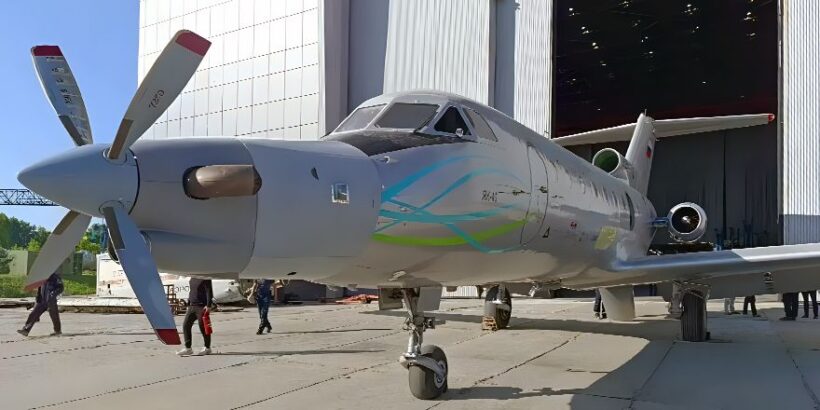The Siberian Research Institute of Aviation named after S.A. Chaplygin (SibNIA) has completed the installation and commissioning of the VK-800SM turboprop engine at its Yeltsovka airfield test facility in Novosibirsk, according to a press release from the Ural Civil Aviation Plant (UZGA).
UZGA, the engine developer, is working together with SibNIA specialists to prepare for flight testing aboard the Yak-40LL flying testbed. The upcoming flight test program will verify engine stability, controllability, and in-flight restart capability across the full range of altitudes and speeds.
The engine, equipped with a four-blade propeller, has been installed in the aircraft’s nose section, replacing the standard weather radar. This work is part of Russia’s State Program for Aviation Industry Development, aimed at integrating the VK-800SM engine and AV-901 propeller into the LMS-901 “Baikal” light multipurpose aircraft. The government contract covers the fifth phase of the “LMS-5” research and development program, with type certification expected by December 17, 2027. The contract value exceeds 10 billion rubles.
“We have successfully completed the installation and commissioning of the VK-800 engine as part of the certification flight testing program using the Yak-40 flying testbed. The next step will be the flight test campaign,” said representatives from SibNIA’s test center.
The VK-800SM engine is designed for four different aircraft types. Besides the LMS-901, it will power the UTS-800 training aircraft and the Russian-Belarusian regional LMS-192 “Osvey” aircraft. The VK-800SM is also planned for re-engining locally assembled L-410 aircraft.
Maximum shaft power ranges from 807 to 877 horsepower depending on the application. Development is underway under contract with Russia’s Ministry of Industry and Trade, with maintenance and operational requirements meeting or exceeding those of contemporary foreign counterparts.
Engine design began in 2019. The gas generator was assembled in 2022, followed by factory development testing in 2023. In 2024, the design documentation received the “O” designation, marking completion of the development phase and transition to the testing program.
Sergey Vakushin, Chief Designer of UZGA’s Engine Division, announced in spring 2023 that flight testing of the VK-800SM on the flying testbed would begin in Q1 2024. Approximately 20 flights are planned in Novosibirsk. Certification flight testing integrated with the “Baikal” aircraft is scheduled to start in Q3 2024, with the full test cycle expected to finish by the end of 2025.
About the Yak-40LL Flying Testbed (Registration 87251)
The Yak-40 passenger aircraft with tail number USSR-87251 was built in 1973 at the Saratov Aircraft Plant. After 20 years of scheduled passenger service with the Lithuanian Civil Aviation Administration of the USSR, the aircraft was re-registered as RA-87251 in 1993 and transferred to SibNIA. It has been used for flight testing and as a calibration aircraft for radio navigation landing systems. In 2018, it was adapted to test a 500-kW electric aviation motor based on high-temperature superconductors (HTS).
For preparation of the ground support unit (GSU) testing, the original AI-25 side-mounted engines were replaced with Garrett TFE731 turbofan units, while the third central engine was replaced with a TV2-117 turboshaft engine mounted on a special frame. A permanent magnet electric generator was installed on the TV2-117 turbine shaft to supply power to the electric motor. Battery packs were installed in the aft fuselage. The 500-kW superconducting electric motor driving the propeller was installed in the Yak-40LL’s nose section, along with a liquid nitrogen cryogenic cooling system.
On July 21, 2021, during the second day of the MAKS Air Show, the modified Yak-40LL (tail number 87251) completed its maiden flight with the hybrid powerplant demonstrator operating. Prior to the air show, the aircraft flew nonstop from Novosibirsk to Zhukovsky using only its two standard turbojet engines, without engaging the hybrid powerplant system.
This same aircraft will now conduct a series of flights as part of the VK-800SM turboprop and AV-901 propeller development testing program.



 (3 votes, average: 3.33 out of 5)
(3 votes, average: 3.33 out of 5)